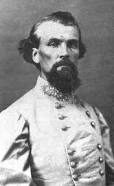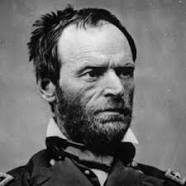
(Lieutenant General Nathan Bedford Forrest. Library of Congress).
We will get to the strategic picture on the progress of the Union Anaconda squeezing the Confederacy tomorrow, since I need to introduce you to a figure of some note in this tale of the future brother-in-laws. His name is Forrest, Nathan Bedford Forrest, in full, and the greatest cavalry soldier of his age.
Round these parts, of course, we would probably bestow that title on the dashing cavalier J.E.B. Stuart, who spent the winter of 1862-63 in Culpeper, and attended the Episcopal Church on East Street. So we consider him a local boy with a certain proprietary pride.
John Singleton Mosby has his partisans as well, and he never got caught as he harried the Federals in Loudoun and Fauquier Counties with gusto. On the Union side, bold George Armstrong Custer fought here before going to his eternal fame- or infamy- in the war against the Souix and phlegmatic John Buford who saved the Union bacon on the first day at Gettysburg.
But I think the greatest horseman of them all was a Tennessean named Nathan Bedford Forrest. He was so effective at harassing Federal forces in Tennessee and Mississippi that that William Tecumseh Sherman once wrote a dispatch to Lincoln’s Secretary of War Stanton: “Forrest is the very devil, If we must sacrifice 10,000 lives and bankrupt the Federal Treasury, it will be worth it. There will never be peace in Tennessee till Forrest is dead.”
The Union press termed him a brigand and a butcher, and a case can be made that he was a war criminal. The same case could be made about Sherman himself, or Phil Sheridan for their campaigns of total violence in the Shenandoah Valley and later in Georgia on the March to the Sea.

(William Tecumseh Sherman’s memorable quote was “War is Hell.” Photo Library of Congress).
In the end, though, only one man was ever held accountable for crimes against humanity in the sprawling conflict. I will get to him and his bill of particulars against the comrades of my Great Great Grandfather presently.
Before the war, Forrest was a self-made millionaire who came from humble stock. His family included eleven children. Back-woods skills were the stuff of existence there, including hunting and tracking and subsistence farming. Formal schooling was not a priority.
One tale told by author Rick Montes about his formative years demonstrates the origin of his boldness. “Young Bedford (was) being intimidated by a group of young toughs at his Uncles tailor shop. The boys seemed intent on harassing the younger boy and continued to taunt him. Finally, Nathan had enough, grabbed a pair of shears and sprang from his seat towards his antagonist. The boys ran in fear. This taught young Bedford a valuable lesson: He could intimidate and disarm an apparently superior foe.”
Forrest was a gambler, and enjoyed the tumult of commerce, though part of that commerce was the trade of human beings. He is said to have been a humane master, insofar as that was unusual in the Peculiar Institution, though goodness knows at this distance it is an appalling thing.
Was his belief a criminal delusion? During an interview after the War with the Cincinnati Commercial newspaper, Bedford was quoted as saying: “When I entered the army I took forty-seven Negroes into the army with me, and forty-five of them were surrendered with me. I told these boys that this war was about slavery, and if we lose, you will be made free. If we whip the fight and you stay with me you will be made free. Either way you will be freed. These boys stayed with me, drove my teams, and better confederates did not live.”
When war broke out in April 12,1861, Forrest appeared at the recruiting station with his entourage and walked into the office of Captain Josiah White’s Tennessee Mounted Rifles. He enlisted as a private along with his brother Jeffrey and fifteen year old son, Willie. This would become the renowned 7th Tennessee Cavalry, and Forrest decided to open his substantial wallet and equip them himself.
His philosophy was made clear in the advertising broadsheets for the unit: “I wish none but those who desire to be actively engaged. COME ON BOYS, IF YOU WANT A HEAP OF FUN AND TO KILL SOME YANKEES.”
If that seems a bit blunt, put it in context. Legendary Five-star Admiral Bill “Bull” Halsey had a completely sign erected on a hillside on the island of Tulagi that welcomed newcomers with the admonition to: “KILL (the enemy)! KILL (the enemy)!KILL MORE (of the enemy)! You will help to kill the (racial characterization) bastards if you do your job well”
I know, I know. I have sanitized the phrase in the interest of delicacy, though there is nothing delicate about total war. These days when we terminate people with prejudice we are supposed to be humane about it, or at least look a little embarrassed, but it has been a while since we actually won a war. Both Forrest and Halsey recognized an important component of warfare: niceties are best reserved for the peacetime that comes after victory.
As part of the process of outfitting the 7th Tennessee, Forrest was appointed Colonel, an impressive rise in circumstance, and by the end of 1862 when this chapter of the family story is being told has put on the one-star of a Brigadier.
At the end of things in 1865 he was a Lieutenant General. Along the way he is personally credited with killing two-dozen Yankees. Author Montes draws a distinction from current rhetoric with Forrest: “He never led from the rear but always from the front,” and he never sent his troops anywhere he was not prepared to go himself.
In 1862 at Fort Donelson, where Uncle Patrick’s unit was captured, Forrest outfought Ulysses S. Grant’s regular army soldiers. As the Rebel leadership made the decision to capitulate, Forrest was quoted as saying “To Hell with that, I did not come here to surrender!” He and his horsemen slipped away to fight another day, and fight they did.
I suspect the Marines in France in 1918 who were ordered to retreat at Belleau Wood might have read Forrest’s history, since they told the French: “Retreat? Retreat hell. We just got here.”
Forrest operated very much like a Marine with his own scheme of logistics. He replenished his men’s kit with captured Yankee arms, allowing his men to be some of the best-equipped men in the Confederate army, including the new Sharp’s repeating rifle that was a remarkable force multiplier.
When he captured a vanquished Union army officer’s sword and noticed that it was only sharp for the first couple of inches on the blade, Forrest demanded a grindstone. When one of his military-educated officers indicated that it was more for show than for fighting, Forrest made one of his more famous quotes: “Damn such nonsense. War means fightin’ and fightin’ means killin’. Turn the grindstone.”
Part of the Forrest legacy is the allegation of a war crime. On April 12, 1864, he led his forces in the attack and capture of Fort Pillow, on the Mississippi River near Henning, TN. There is no question that a massacre took place against US Colored Troops; the question is whether the Union Command had ever surrendered, or whether this was a question of the enforcement of “no quarter” was being applied. Whatever it was, the incident demonstrated the evolving and savage nature of the subsequent conduct of the War by both sides.
Forrest is often misquoted to highlight his lack of formal education. The New York Tribune claimed he said his strategy was to “git thar fustest with the mostest.” Now often recast as “Getting there firstest with the mostest,” The folksy quote was corrected by a New York Times story in 1918 to be: “Ma’am, I got there first with the most men.”
He normally did, being one of the first generals in the war to apply the principals of mass and maneuver on a grand scale.
Some of Bedford’s greatest victories came by using psychological warfare. He repeatedly used deceit to trick his foes into thinking that he had greater numbers then he actually had and would sometimes capture twice his number.
That becomes part of this story and I will tell it on the anniversary of the battle on the 10th of June, which leads to a direct encounter with the only man who was hanged for what he did.
Copyright 2015 Vic Socotra
www.vicsocotra.com
Twitter: @jayare303
